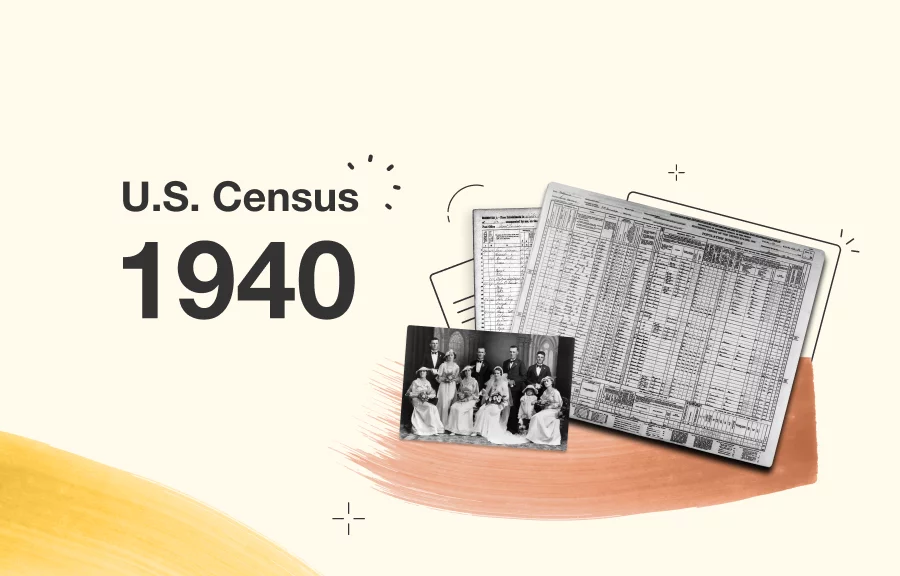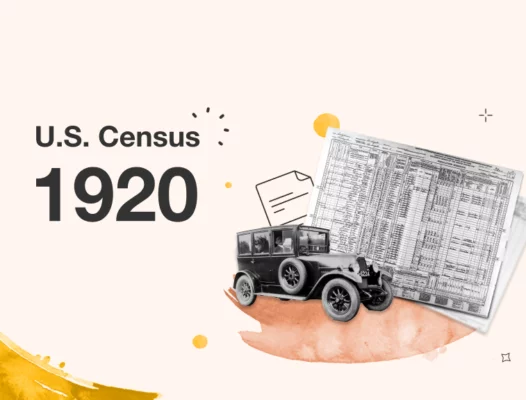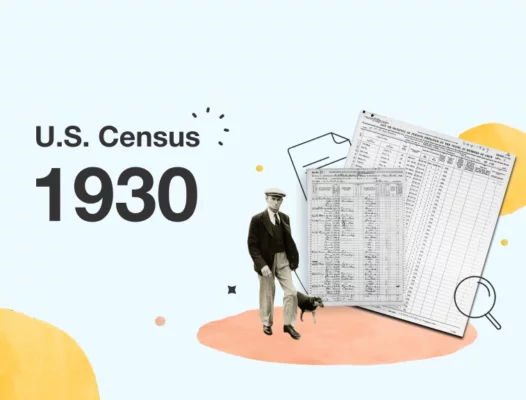The 1940 U.S. Census: Discover Your Family History from 1940

The 1940 U.S. Census was taken during a challenging time in American history. The beginning of the new decade found the country was just emerging from the Great Depression, and the severe dust storms of the Dust Bowl were still wreaking havoc in the prairies. War was raging in Europe, though it had not yet reached American shores. It was also a time of great feats of architecture, from the Empire State Building to the Hoover Dam, as well as exciting new inventions, from the Polaroid camera to the jet engine.
Read on to learn what the 1940 Census can reveal to you about your ancestors living in the United States in 1940.
What can the 1940 Census show us about our ancestors?
The 1940 Census was the most detailed in U.S. history, with more questions than any other census that came before or after. The information it gathered included:
- Name
- Age
- Place of residence
- Place of birth
- Relationship to head of household
- Gender
- Race
- Education level
- Citizenship
- Residence in 1935
- Information about income
- Occupation
- Whether they owned or rented their home
- The value of their home, or what they paid in rent
What changed from the 1930 Census to the 1940 Census?
The population of the United States increased 7.3%, from 122,775,046 in 1930 to 132,164,569 in 1940 — a significant decrease in growth rate from the previous decade, which had seen a population growth of 13.7%.
This census holds the record for the highest number of questions asked on a census: a total of 38 questions were asked of the general population, with 2 people per page answering an additional 12 questions for a total of 50! Some of the new questions included the person’s residence 5 years prior (to gather information about migration) and the highest level of education this person had completed. It was also the first census to ask about the family income, and this question was deliberately placed at the end, because authorities worried that people would take offense at this question and kick the enumerator out, and they wanted to be sure the enumerator gathered the rest of the information before that happened!
Some of the questions omitted included whether the family had a radio set, which was only asked in 1930, and whether the residents could read or write — an indication that literacy rates had risen enough that this question was no longer relevant.
The next significant change from 1930 to 1940 was that this census introduced sampling techniques. Asking every resident of the U.S. 50 questions would have been a serious burden both for record-keepers and the people being interviewed. Instead, 2 lines on each 40-line form were selected to answer 12 supplementary questions, which allowed the government to collect information from a sample of 5% of the population.
If you’re lucky, one or more of your ancestors will fall on a sample line, allowing you to learn even more about them: where their parents were born, whether they were a military veteran or the wife or child of one, their mother tongue, information about social security, and additional details about their occupation and marriage and childbearing history.
Searching the 1940 Census on MyHeritage
While census records are available to the public on the National Archives website, searching on MyHeritage offers invaluable additional benefits:
- Advanced search capabilities: Using MyHeritage’s search engine, you can search for your ancestors according to any criteria and not just home address or enumeration district. MyHeritage’s sophisticated search algorithms can even identify nicknames and name variations from other languages.
- Easily flip between records within the family: MyHeritage allows you to easily flip between census records of individuals in the same family group. Family members are listed on the record page, and you can click their names to go to their records.
- Explore related records: When you are viewing records on MyHeritage, you’ll see additional historical records that mention the person you are researching. Our database includes more than 16 billion records and is constantly growing.
- Receive automatic Record Matches: When you build a family tree on MyHeritage, you won’t even need to search actively. MyHeritage finds historical records that mention the people in your family tree and delivers them straight to your inbox.
- Extract new information straight to your family tree: Extracting information from historical records and placing it on your online family tree is as simple as a few clicks on MyHeritage.
Get more great tips by watching Preparing for the 1950 Census: How-to Search the U.S. Census Records:
What does a 1940 Census record look like?
Below is an example of the population questionnaire from the 1940 Census. This record, from Westchester county in New York, features John F. Kennedy and his family. The future president (line 56) was 23 years old at the time and living with his parents and siblings as well as a maid, a cook, and a secretary.
![Census record of JFK and family [Credit: MyHeritage 1940 United States Federal Census]](https://cm.myheritage.com/wp-content/uploads/2022/02/Kennedy1940.jpg)
Census record of JFK and family [Credit: MyHeritage 1940 United States Federal Census]
Questions included in the 1940 Census form
Below is a complete list of the questions included in the 1940 Census:
LOCATION:
- Street, avenue, road, etc.
- House number (in cities and towns)
HOUSEHOLD DATA:
- Number of household in order of visitation
- Home owned (O) or rented (R)
- Value of home, if owned, or monthly rental, if rented
- Does this household live on a farm? (Yes or No)
NAME:
- Name of each person whose usual place of residence on April 1, 1940, was in this household
RELATION:
- Relationship of this person to the head of the household, as wife, daughter, father, mother-in-law, grandson, lodger, lodger’s wife, servant, hired hand, etc.
PERSONAL DESCRIPTION:
- Sex — Male (M), Female (F)
- Color or race
- Age at last birthday
- Marital status — Single (S), Married (M), Widowed (Wd), Divorced (D)
EDUCATION:
- Attended school or college any time since March 1, 1940? (Yes or No)
- Highest grade of school completed
PLACE OF BIRTH:
- If born in the United States, give State, Territory, or possession. If foreign born, give country in which birthplace was situated on January 1, 1937. Distinguish Canada-French from Canada-English and Irish Free State (Eire) from Northern Ireland.
CITIZENSHIP:
- Citizenship of the foreign born
RESIDENCE, APRIL 1, 1935:
In what place did this person live on April 1, 1935?
- City, town, or village having 2,500 or more inhabitants. Enter “R” for all other places.
- County
- State
- On a farm?
PERSONS 14 YEARS OLD AND OVER — EMPLOYMENT STATUS
- Was this person AT WORK for pay or profit in private or nonemergency Govt. work during week of March 24–30? (Yes or No)
- If not, was he at work on, or assigned to, public EMERGENCY WORK (WPA, NYA, CCC, etc.) during week of March 24–30? (Yes or No)
If neither at work nor assigned to public emergency work:
- Was this person SEEKING WORK? (Yes or No)
- If not seeking work, did he HAVE A JOB, business, etc.? (Yes or No)
For persons answering “No” to quest. 21, 22, 23, and 24:
- Indicate whether engaged in home housework (H), in school (S), unable to work (U), or other (Ot)
- If private or nonemergency Government work (“Yes” in Col. 21): Number of hours worked during week of March 24–30, 1940
- If seeking work or assigned to public emergency work (“Yes” in Col. 22 or 23): Duration of unemployment up to March 30, 1940 — in weeks
OCCUPATION, INDUSTRY, AND CLASS OF WORKER
- OCCUPATION: Trade, profession, or particular kind of work, as — frame spinner, salesman, laborer, rivet heater, music teacher
- INDUSTRY: Industry or business, as — cotton mill, retail grocery, farm, shipyard, public school
- Class of worker
- Number of weeks worked in 1939 (Equivalent full-time weeks)
INCOME IN 1939 (19 months ending December 31, 1939)
- Amount of money wages or salary received (including commissions)
- Did this person receive income of $50 or more from sources other than money wages or salary? (Yes or No)
- Number of Farm Schedule
SUPPLEMENTARY QUESTIONS
For persons enumerated on Lines 14 and 29
- NAME
PLACE OF BIRTH OF FATHER AND MOTHER
If born in the United States, give State, Territory, or possession. If foreign born, give country in which birthplace was situated on January 1, 1937. Distinguish Canada-French from Canada-English and Irish Free State (Eire) from Northern Ireland.
- FATHER
- MOTHER
MOTHER TONGUE (OR NATIVE LANGUAGE)
- Language spoken in home in earliest childhood
VETERANS
Is this person a veteran of the United States military forces; or the wife, widow, or under-18-year-old child of a veteran?
- If so, enter “Yes”
- If child, is veteran father dead? (Yes or No)
- War or military service
FOR PERSONS 14 YEARS OLD AND OVER
SOCIAL SECURITY
- Does this person have a Federal Social Security Number? (Yes or No)
- Were deductions for Federal Old-Age Insurance or Railroad Retirement made from this person’s wages or salary in 1939? (Yes or No)
- If so, were deductions made from (1) all, (2) one-half or more, (3) part, but less than half, wages or salary?
USUAL OCCUPATION, INDUSTRY, AND CLASS OF WORKER
- USUAL OCCUPATION
- USUAL INDUSTRY
- Usual class of worker
FOR ALL WOMEN WHO ARE OR HAVE BEEN MARRIED
- Has this woman been married more than once? (Yes or No)
- Age at first marriage?
- Number of children ever born (Do not include stillbirths)
What can the 1940 census show us about your ancestors? Discover your family’s stories from the 1940 U.S. Census!



